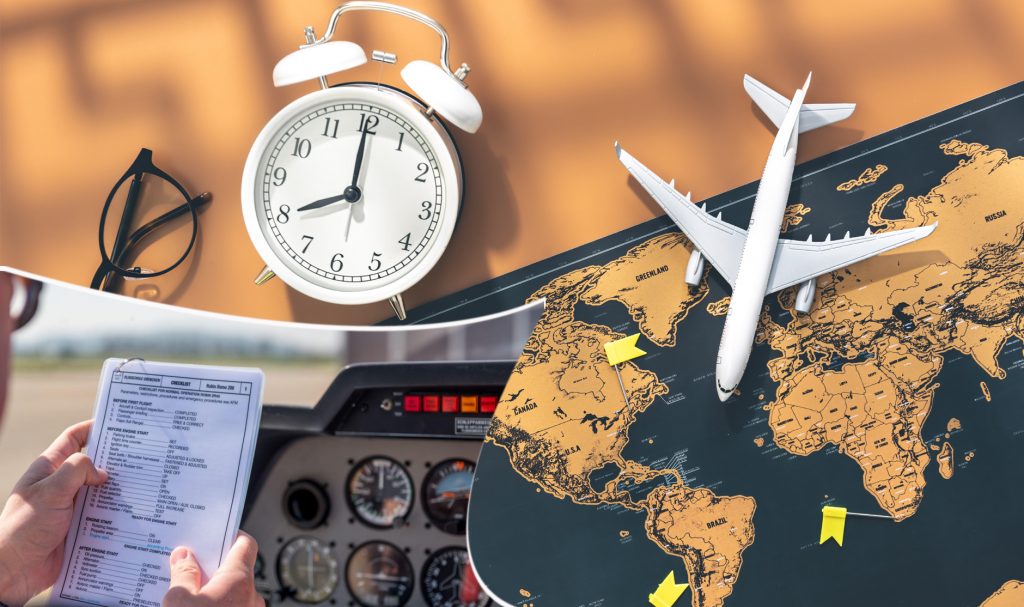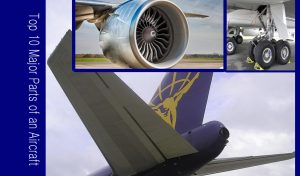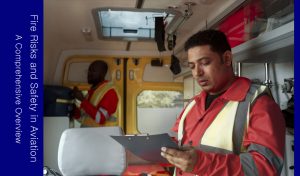Introduction, Navigating the sky requires careful flight planning, whether you’re a pilot of a small private aircraft or an airline captain. Proper flight planning ensures safety, efficiency, and compliance with aviation regulations. Here are some flight planning tips and tools to help you navigate the skies:
The Importance of Flight Planning
Before embarking on a journey through the skies, it’s crucial to have a well-thought-out plan. Flight planning is not just a formality; it’s the foundation of a safe and efficient flight. Without proper planning, you’d be navigating the vast and often unpredictable atmosphere blindly. It’s akin to setting sail on the open sea without a map or compass.
When you consider the complexities of modern aviation, including varying weather conditions, airspace restrictions, and the performance capabilities of your aircraft, flight planning becomes an indispensable tool for pilots. In this article, we’ll explore the key elements of flight planning that every aviator, whether seasoned or novice, should be well-acquainted with.

Weather Considerations
Understanding the Skies’ Moods
Weather considerations are paramount in flight planning, as weather conditions can significantly impact the safety and efficiency of a flight. Pilots must continually monitor and assess weather factors throughout their journey. Here are some key weather considerations in flight planning:
1. Pre-Flight Weather Briefing:
- Before every flight, obtain a comprehensive weather briefing from official sources such as Flight Service Stations (FSS), Automated Flight Service Stations (AFSS), or online aviation weather services.
2. Weather Sources:
- Utilize a combination of weather sources, including:
- METARs (Meteorological Aerodrome Reports): These reports provide current weather conditions at airports and are updated at least once an hour.
- TAFs (Terminal Aerodrome Forecasts): TAFs provide short-term forecasts for airport-specific weather conditions.
- SIGMETs (Significant Meteorological Information): SIGMETs highlight significant weather phenomena such as severe turbulence, icing, or thunderstorms.
- Area Forecasts: These forecasts cover broader regions and provide information on en-route weather conditions.
3. Weather Elements to Consider:
- Visibility: Low visibility due to fog, rain, snow, or other factors can impact takeoff, landing, and en-route safety.
- Cloud Cover: Pay attention to cloud types, heights, and coverage, as they can affect flight visibility and ceiling limitations.
- Wind: Consider wind speed and direction, especially during takeoff and landing. Crosswinds and strong winds aloft can affect aircraft performance.
- Temperature and Dew Point: Temperature and dew point spread can indicate the potential for fog, frost, or ice formation.
- Precipitation: Rain, snow, sleet, or freezing rain can affect flight conditions, including aircraft icing.
- Turbulence: Turbulence can result from various weather phenomena and impact passenger comfort and aircraft stability.
- Icing: Pay attention to areas of potential icing, especially when flying through clouds, as it can affect aircraft performance and safety.
- Thunderstorms: Thunderstorms can bring severe turbulence, lightning, hail, and heavy precipitation. Avoid flying through or near thunderstorms whenever possible.
4. Weather Radar and Satellite Imagery:
- Use onboard weather radar and satellite imagery to monitor real-time weather conditions during flight.
Destination Assessment
Where to Land Safely
The choice of your destination airport is critical. While it may seem obvious, it’s not just about finding a place to touch down. Different airports have different facilities, services, and operating hours. You need to consider factors such as runway length, instrument approaches, and customs clearance, depending on your journey’s nature.
Additionally, your destination may also be affected by weather or other operational issues, so it’s essential to have alternate airports in mind as part of your flight plan.
Aircraft Performance Data
Knowing Your Machine
Aircraft performance data is crucial in flight planning, as it helps pilots determine the capabilities of their aircraft, plan routes, calculate fuel requirements, and ensure safe and efficient operations. Here are some key aspects of aircraft performance data in flight planning:
1. Takeoff Performance:
- Takeoff Distance: APD-Aircraft performance data provides information on the minimum runway length required for takeoff under specific conditions, such as aircraft weight, altitude, temperature, and wind. Pilots use this data to ensure they have enough runway length available.
- Climb Performance: Data on the aircraft’s climb rates and capabilities at different altitudes are used to plan the initial climb after takeoff and subsequent climbs during the flight.
2. Cruise Performance:
- Cruise Speed and Altitude: Aircraft manuals and charts provide data on the optimal cruise speed and altitude for fuel efficiency and distance covered. This information helps pilots plan the most efficient route and altitude based on winds and weather conditions.
3. Descent Performance:
- Descent Rates: Information on the descent rate at various altitudes and speeds is essential for planning descents and approaches to the destination airport.
4. Landing Performance:
- Landing Distance: Again Aircraft performance data includes landing distance calculations, which are influenced by factors like aircraft weight, altitude, temperature, and wind. This data helps ensure a safe landing and rollout on the runway.
- Approach Speeds: Data on approach speeds, including Vref (reference speed), helps pilots maintain the correct approach and landing speeds for safe operations.
Fuel Management
Keeping Your Flight on a Full Tank
Effective fuel management is a critical component of flight planning, ensuring that the aircraft has enough fuel to complete the journey safely, account for contingencies, and comply with regulations. Here are the key aspects of fuel management in flight planning:
1. Calculate Fuel Requirements:
Use performance charts and aircraft-specific data to calculate the required fuel for the planned flight. Consider factors such as distance, aircraft weight, route, altitude, and expected wind conditions.
2. Reserve Fuel:
Regulations typically require pilots to carry a certain amount of reserve fuel, often expressed as a fixed time or distance, to account for unforeseen circumstances, diversions, and holding patterns. Common reserve requirements include:
- Contingency Fuel: To account for unexpected deviations, weather-related delays, or air traffic congestion.
- Alternate Fuel: Fuel needed to fly to an alternate airport in case the destination airport is unavailable due to weather or other reasons.
- Final Reserve Fuel: A fixed amount of fuel to be carried at the destination, ensuring a safe reserve for landing, taxiing, and possible go-arounds.
3. Minimum Fuel Requirements:
Understand and comply with minimum fuel requirements established by aviation authorities, which may vary by country and type of operation.
4. Fuel Load Management:
Distribute fuel evenly in the aircraft’s fuel tanks to maintain proper weight and balance.
5. Fuel Quality:
Ensure that the fuel used meets aviation standards and is free from contaminants. Check for any NOTAMs related to fuel quality at departure and destination airports.
6. Fueling Procedures:
Adhere to proper fueling procedures, including checking the quantity and quality of fuel, ensuring correct fuel additives are used, and properly securing fuel caps.
7. Weather Impact:
Consider weather-related factors that can affect fuel consumption, such as headwinds or strong winds aloft, which may require additional fuel reserves.
8. Fuel Efficiency:
Plan for the most fuel-efficient altitudes and airspeeds based on aircraft performance data and weather conditions to optimize fuel consumption.
9. Diversion Planning:
In case of unplanned diversions, calculate the additional fuel needed to reach an alternate airport or return to the departure airport.
10. Monitor Fuel During Flight:
Continuously monitor fuel consumption and compare it to the planned consumption. Adjust the flight plan if necessary to ensure you have sufficient reserves.
11. Fuel Dumping:
If the aircraft is carrying excess fuel and needs to land due to an emergency or maintenance issue, consider fuel dumping procedures to reduce the aircraft’s weight to a safe landing level.
Air Traffic Control
Navigating the Skies with Confidence
Air Traffic Control (ATC) plays a central role in flight planning and ensuring safe and efficient air traffic operations. Effective communication with ATC is crucial for pilots to receive guidance, clearances, and assistance during all phases of a flight. Here’s how ATC is integrated into flight planning:
1. Filing a Flight Plan:
Before departure, pilots are required to file a flight plan with the appropriate ATC facility, which provides information about the route, altitude, estimated time of departure (ETD), estimated time en route (ETE), and estimated time of arrival (ETA).
2. Departure Procedures:
ATC provides departure clearances, which may include initial altitudes, headings, and routes to follow after takeoff. These clearances help guide the aircraft safely out of the terminal airspace.
3. En-Route Communication:
Pilots are in constant communication with ATC during the en-route phase, providing position reports, requesting altitudes and route changes, and receiving weather updates and traffic advisories.
4. Routing and Altitude Adjustments:
ATC may provide routing and altitude adjustments to account for traffic, weather, or other considerations. This dynamic routing is essential for maintaining safe separation between aircraft.
5. Weather Updates:
ATC facilities provide pilots with real-time weather updates, including advisories on turbulence, thunderstorms, icing, and other meteorological conditions that may affect the flight.
6. Traffic Separation:
ATC ensures that aircraft are safely separated in the airspace, whether by providing radar vectors, assigning altitudes, or sequencing arrivals for landing.
7. Approaches and Arrivals:
ATC guides aircraft during the approach and landing phases, providing instructions for descending, configuring the aircraft for landing, and sequencing for a safe approach and landing.
8. Emergency Assistance:
In the event of an emergency, pilots can request assistance from ATC, including priority handling, vectoring to the nearest suitable airport, and coordinating emergency services.
9. Communication Facilities:
ATC is provided through a network of facilities, including Control Towers at airports, Terminal Radar Approach Control (TRACON) facilities, and Air Route Traffic Control Centers (ARTCCs). Pilots communicate with the appropriate facility based on their location and phase of flight.
10. Airspace Coordination:
ATC helps manage the use of different types of airspace, including controlled, uncontrolled, special-use, and restricted areas. Pilots must adhere to the rules and clearances associated with these types of airspace.
11. Technology and Automation:
ATC facilities use radar, automation systems, and communication tools to assist in managing air traffic. Modern technology, such as ADS-B (Automatic Dependent Surveillance-Broadcast), enhances surveillance and communication capabilities.
12. Emergency Services Coordination:
In the event of an emergency landing or situation, ATC coordinates with search and rescue services, fire departments, and other emergency responders to ensure a swift and effective response.
13. Post-Flight Reporting:
After landing, pilots often provide feedback to ATC on their experience, including any issues or concerns, which can help improve air traffic management.
Effective communication with ATC is vital for the safety of all flights, and pilots should be trained to follow ATC instructions and procedures. It’s essential to maintain open and clear communication with ATC throughout the entire flight to ensure a smooth and safe operation.
Navigation Aids
Tools to Keep You on Course
Navigation aids are essential tools used in flight planning to help pilots determine their position, navigate, and maintain course accuracy throughout a flight. These aids, both ground-based and onboard, provide guidance in various phases of a flight. Here are some common navigation aids used in flight planning:
1. VOR (VHF Omni-Directional Range):
VOR stations are ground-based radio transmitters that emit signals in all directions. Aircraft equipment receives these signals and allows pilots to determine their radial or bearing from the station. Multiple VORs can be used to create airways or define specific routes.
2. DME (Distance Measuring Equipment):
DME equipment measures the slant range distance between the aircraft and a DME ground station. It provides distance information, allowing pilots to verify their position and track along a specific route.
3. NDB (Non-Directional Beacon):
NDBs are ground-based radio beacons that transmit signals in all directions. While less common today, they can still be used for navigation, providing a bearing to or from the station.
4. GPS (Global Positioning System):
GPS is a satellite-based navigation system that provides precise position information to aircraft. It is widely used for navigation, route planning, and approach procedures. GPS receivers on board the aircraft communicate with satellites to determine the aircraft’s position.
5. FMS (Flight Management System):
Flight management systems are sophisticated onboard computers that integrate various navigation aids, including GPS, VOR, and DME data, to assist in route planning, waypoint sequencing, and performance management.
6. ILS (Instrument Landing System):
ILS is a precision approach and landing aid that includes localizer and glide slope components. It provides lateral and vertical guidance to help aircraft align with the runway and descend to a safe landing.
7. RNAV (Area Navigation):
RNAV systems, often integrated with GPS, allow for more flexible and precise navigation, as they use waypoints and distances for route planning. They can be used to create custom flight paths.
8. RADAR:
Ground-based radar systems provide air traffic control with real-time aircraft position information. Pilots can also use onboard weather radar for detecting and avoiding weather-related hazards.
9. ADF (Automatic Direction Finder):
ADF equipment receives radio signals from NDBs and provides a relative bearing to the NDB station. It is less accurate than VOR but can be used for navigation in areas without VOR coverage.
10. INS (Inertial Navigation System):
INS uses accelerometers and gyros to determine an aircraft’s position based on its initial position and velocity. It’s often used in combination with other navigation aids for long-range navigation.
11. Charts and Maps:
In addition to electronic navigation aids, pilots use aeronautical charts, including sectional charts, en-route charts, and approach plates, to visually reference and navigate during a flight.
12. ATC Services:
Air traffic control provides guidance and clearances to assist pilots with navigation, including headings, altitudes, and route changes.
Effective flight planning incorporates a combination of these navigation aids, and modern aircraft often rely on a mix of these systems to ensure accurate and safe navigation from takeoff to landing. Pilots are trained to use these aids in tandem with current weather information and air traffic control instructions to conduct their flights safely and efficiently.
Altitude and Airspace
Understanding the Vertical Dimension
Altitude and airspace considerations are critical aspects of flight planning. Understanding and adhering to altitude restrictions and the requirements of different airspace classes are essential for safe and compliant flight operations. Here’s a breakdown of how altitude and airspace come into play in flight planning:
1. Altitude Considerations:
- Cruising Altitude: The chosen cruising altitude depends on factors such as aircraft type, weight, and the planned route. It should provide for fuel efficiency and separation from other traffic. Flight planning tools and performance data help determine the optimal cruising altitude.
- Minimum En-Route Altitude (MEA): MEA is the lowest altitude at which an aircraft may be flown on a particular airway or route segment. It ensures safe obstacle clearance.
- Minimum Safe Altitude (MSA): MSA is the minimum altitude at which an aircraft may fly in a particular area to ensure safe terrain clearance. It is used for emergency navigation and cannot be lower than the highest obstruction within a specified radius.
- Minimum IFR Altitudes (MIA): MIAs are established for various segments of airways, routes, and holding patterns. They provide obstacle clearance and navigation accuracy under instrument flight rules (IFR) conditions.
- Altitude Deviations: Some airspace areas have specific altitudes or flight levels for specific purposes, such as military operations, glider operations, or skydiving. Pilots must be aware of these restrictions and comply with them.
2. Airspace Considerations:
- Class A Airspace: Class A airspace typically starts at 18,000 feet MSL (mean sea level) and extends up to 60,000 feet MSL. It is a controlled airspace, and IFR operations are required. In Class A airspace, aircraft are under positive ATC control at all times.
- Class B Airspace: Class B airspace surrounds major airports and is designed to manage high-density traffic. Entry into Class B airspace requires ATC clearance, and both IFR and VFR operations are subject to strict control.
- Class C Airspace: Class C airspace is found around airports with moderate traffic levels. Both IFR and VFR flights are allowed, but two-way radio communication with ATC is required for entry.
- Class D Airspace: Class D airspace surrounds smaller airports with control towers. Two-way radio communication with ATC is required for entry, but IFR and VFR flights are allowed.
- Class E Airspace: Class E airspace covers controlled airspace that is not Class A, B, C, or D. It can vary from surface to 18,000 feet MSL and is used for IFR and VFR operations.
- Class G Airspace: Class G airspace is uncontrolled airspace, often found at lower altitudes away from airports. It is where most VFR flights take place. Clearance from ATC is not required, but pilots must adhere to specific visibility and cloud-clearance requirements.
- Special Use Airspace: Special use airspace includes areas like military operating areas (MOAs), restricted areas, and prohibited areas. Flight planning should account for these areas, and pilots must adhere to restrictions when entering them.
3. Transition Altitude and Level:
Transition altitude is the altitude at which aircraft change from using local altimeter settings to a standard pressure setting (usually 29.92 inHg or 1013.25 hPa) when climbing to higher altitudes. Transition level is the same concept, but for descending from higher altitudes to lower ones.
4. Flight Levels:
Flight levels are used in Class A airspace and in some portions of Class E airspace above the transition altitude. They are expressed in hundreds of feet (e.g., FL350 for 35,000 feet). This standardization eliminates altimeter setting errors and ensures separation.
5. Special Air Traffic Rules:
Some airspace may have unique rules or regulations, such as Terminal Radar Service Areas (TRSA), Controlled Firing Areas, or Special Flight Rules Areas (SFRA). Pilots must be aware of these when planning their routes.

Proper flight planning incorporates considerations of altitude and airspace to ensure that the aircraft operates safely and within the confines of relevant regulations and requirements. Pilots should have access to current charts, aeronautical information, and air traffic control services to assist with navigating various altitudes and airspace classes.
Route Planning
Charting Your Course
Route planning is a critical component of flight planning that involves selecting the most efficient and safe path from the departure airport to the destination airport while taking into account factors such as airspace restrictions, airways, weather, and navigation aids. Here are the key steps and considerations in route planning:
1. Determine the Desired Route:
Identify the departure and destination airports and determine the general direction of the route. Consider factors such as airspace restrictions, terrain, and the need to avoid congested areas.
2. Consider Airspace:
Review the airspace along the route. Different airspace classes (e.g., Class A, B, C, D, E, and G) have various requirements and restrictions. Ensure that your planned route complies with these airspace rules.
3. Use Airway Routes:
Airways are predefined routes in the sky that help guide aircraft along specific corridors. Airways often provide well-established routes for navigation. Include airway segments in your route when possible.
4. Avoid Restricted and Prohibited Areas:
Check for restricted and prohibited areas on your planned route. These areas are off-limits or require special permissions to enter.
5. Incorporate Waypoints:
Identify waypoints along the route, such as VORs, NDBs, intersections, and GPS waypoints. Waypoints serve as navigation references and help define the route.
6. Consider ETOPS (Extended-range Twin-engine Operational Performance Standards):
For twin-engine aircraft on long-haul flights, comply with ETOPS regulations, which define routes that ensure the aircraft can reach an alternate airport within a certain time frame in the event of an engine failure.
Alternate Airports
Preparing for the Unexpected
No flight ever goes entirely as planned. It’s essential to have alternate airports in mind in case of unexpected diversions due to weather, medical emergencies, or other unforeseen events.
These alternative airports should be selected based on factors like proximity to your planned route and the operational capabilities they offer.
Weight and Balance
The Art of Distributing Weight
Weight and balance considerations are fundamental to flight planning and ensure the safe operation of an aircraft. Pilots and flight planners must calculate and maintain an aircraft’s weight and balance within specified limits. Here are the key aspects of weight and balance in flight planning:
1. Weight:
- Basic Empty Weight: This is the aircraft’s weight when it’s in a standard configuration, including all the necessary equipment and fluids, but without any passengers, cargo, or fuel.
- Operating Empty Weight: This weight includes the basic empty weight along with items like crew members, fluids (such as engine oil and hydraulic fluid), and any other equipment required for the aircraft’s normal operation.
- Payload: Payload includes passengers, baggage, cargo, and any additional items carried on the aircraft. The weight of passengers and cargo varies from flight to flight and must be carefully calculated.
- Fuel Weight: The weight of the fuel on board is a significant factor in the total weight of the aircraft. Fuel consumption during the flight also affects weight.
2. Balance:
Center of Gravity (CG): The center of gravity is a point within the aircraft where it would balance if it were suspended in the air. Maintaining the CG within specified limits is crucial for stability and control during flight.
3. Calculations:
Use performance charts and aircraft manuals to calculate the total weight and balance of the aircraft for a specific flight. These calculations are typically performed before departure, and adjustments may be necessary to ensure compliance with weight and balance limits.
4. Regulatory Compliance:
Regulatory authorities set maximum weight and balance limits for each aircraft type. Pilots must adhere to these limits for safety and regulatory compliance.
5. Weight and Balance Documents:
Maintain weight and balance documents that provide a record of the aircraft’s current configuration, including its weight, balance, and equipment. These documents are essential for compliance and safe flight.
6. Loading Procedures:
Ensure that passengers, baggage, and cargo are properly distributed within the aircraft to maintain the desired CG. Follow loading procedures to distribute weight evenly.
NOTAMs and TFRs
Staying Informed
NOTAMs (Notices to Airmen) and TFRs (Temporary Flight Restrictions) are essential elements of flight planning, providing critical information about temporary changes or restrictions in the airspace. Pilots and flight planners should check and consider these notifications to ensure safe and compliant flight operations. Here’s an overview of NOTAMs and TFRs in flight planning:
1. NOTAMs (Notices to Airmen):
- What Are NOTAMs? NOTAMs are notices provided by aviation authorities and airport operators to inform pilots and aviation personnel about significant changes or conditions at an airport or within a particular airspace.
- Types of NOTAMs: NOTAMs come in various types, including NOTAM-D (Distant), NOTAM-L (Local), NOTAM-T (Temporary), NOTAM-P (Permanent), and NOTAM-C (Center).
- Information in NOTAMs: NOTAMs can contain information about runway closures, changes in airport lighting, navigational aids out of service, airspace restrictions, or any other conditions that might affect flight safety.
- Importance in Flight Planning: Pilots and flight planners must review NOTAMs before a flight to be aware of any changes or conditions that could impact the safety and efficiency of the flight. It is a regulatory requirement to check for NOTAMs before each flight.
- Sources of NOTAMs: NOTAMs can be obtained from sources such as the FAA in the United States, Eurocontrol in Europe, and other relevant aviation authorities. Many flight planning tools and services also provide access to NOTAM information.
2. TFRs (Temporary Flight Restrictions):
- What Are TFRs? TFRs are temporary restrictions imposed on the airspace by aviation authorities, usually due to special events, emergencies, or security reasons. TFRs can cover specific altitudes, geographical areas, or volumes of airspace.
- Types of TFRs: There are various types of TFRs, including security TFRs, disaster TFRs, and sports events TFRs. Each type has specific restrictions and requirements.
- Information in TFRs: TFRs provide details about the geographic area, altitude limits, and the purpose of the restriction. This information helps pilots understand the specific limitations in place.
- Importance in Flight Planning: TFRs are critical for flight planning, as flying into restricted airspace can lead to serious consequences, including interception by military aircraft, legal actions, or safety risks.
- Sources of TFRs: TFRs are typically published by the relevant aviation authorities and are available through official channels, including the FAA in the United States. Flight planning software and services also provide TFR information.
3. Incorporating NOTAMs and TFRs into Flight Planning:
- During the flight planning process, pilots and flight planners should actively seek and review NOTAMs and TFRs related to their intended route and destination.
- Tools and services, such as flight planning software and apps, often offer features to automatically retrieve and display NOTAMs and TFRs relevant to a flight plan.
- It is essential to consider NOTAMs and TFRs in route planning, fuel calculations, alternate airport selection, and other aspects of the flight plan.
- Before departure, double-check for any last-minute NOTAMs and TFRs to ensure that you have the most up-to-date information before taking off.
NOTAMs and TFRs are crucial for maintaining safe and compliant flight operations. Staying informed about temporary changes, restrictions, and conditions in the airspace is a primary responsibility for pilots and flight planners during the pre-flight planning process.
Flight Planning Tools
Harnessing Technology for Safer Skies
Flight planning tools are essential resources that help pilots and flight planners prepare for and execute safe and efficient flights. These tools encompass a range of resources and technologies that provide valuable information and assist in various aspects of flight planning. Here are some of the essential flight planning tools and resources:
1. Aeronautical Charts:
Aeronautical charts, including sectional charts, en-route charts, and approach plates, provide detailed visual representations of airspace, airports, navigational aids, and terrain. They help pilots plan routes and navigate during flights.
2. Flight Planning Software and Apps:
Modern flight planning software and mobile apps offer a wide range of features, including route planning, weather information, NOTAMs, airport data, and weight and balance calculations. Popular tools include ForeFlight, SkyVector, and Garmin Pilot.
Flight Planning Regulations
Complying with Legal Requirements
Flight planning regulations are established by aviation authorities to ensure safe and orderly air travel. Compliance with these regulations is a fundamental requirement for all aviation operations. Here are some of the key flight planning regulations and considerations that pilots and flight planners must adhere to:
1. IFR and VFR Regulations:
Aviation authorities, such as the Federal Aviation Administration (FAA) in the United States, define regulations for Instrument Flight Rules (IFR) and Visual Flight Rules (VFR). These regulations specify when and how IFR and VFR flight is conducted, including weather minimums, equipment requirements, and communication procedures.
2. Airspace Regulations:
Regulations define different classes of airspace (Class A, B, C, D, E, and G), each with specific rules and requirements. Compliance with these airspace regulations is essential for safe and orderly operations.
3. Weight and Balance Regulations:
Regulations set weight and balance limitations for aircraft. Pilots and flight planners must ensure that an aircraft’s weight and balance are within these limits to maintain stability and control.
4. Minimum Equipment Lists (MEL):
MELs specify the required equipment and systems for safe flight. Compliance with MELs is mandatory, and any inoperative equipment must be addressed according to established procedures.
Conclusion
In conclusion, flight planning is the backbone of every successful aviation journey. It’s not just about determining your route; it’s a comprehensive process that involves considering weather, aircraft performance, regulations, and more. When done effectively, flight planning ensures safety, efficiency, and peace of mind for pilots and passengers alike. So, remember, before you take off, have a solid plan in place, just like a well-prepared captain setting sail.
FAQs
1. Why is weather so crucial in flight planning?
Weather plays a significant role in flight planning because it affects takeoff, landing, and in-flight conditions. Being informed about the weather helps pilots make informed decisions and ensure a safe journey.
2. What’s the significance of having alternate airports in the flight plan?
Alternate airports provide options in case the primary destination is unavailable due to weather or other issues. They act as safety nets, ensuring you have a place to land if needed.
3. How does technology aid in flight planning?
Technology offers tools for weather updates, route planning, and navigation assistance. It streamlines the flight planning process, making it more efficient and accurate.
4. Why is it essential to comply with flight planning regulations?
Compliance with regulations ensures that aviation operations are safe and orderly. It helps prevent accidents and incidents by establishing clear rules for pilots to follow.
5. What’s the role of air traffic control in flight planning?
Air traffic control provides guidance, separation, and communication for aircraft in controlled airspace. They play a vital role in ensuring safe and organized flights.
These FAQs provide concise answers to some common questions about flight planning. If you have more specific queries or need further details, feel free to ask. Safe travels!









